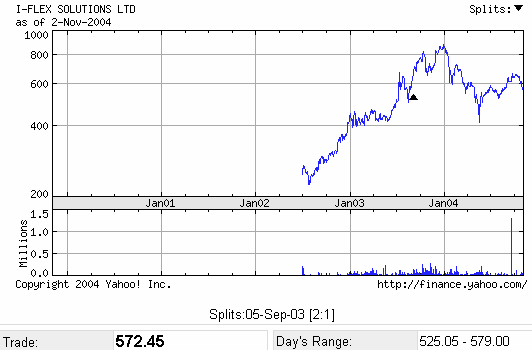It
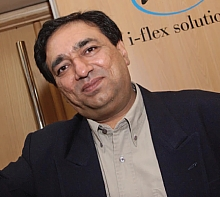 is
8am
on a winter morning in
Manhattan
. i-flex’s team is making a decision on whether to
accept a key negotiating point from a high profile
client. It
has taken the marketing team a lot of work to get the
client to negotiate.
At the head of the table in the
Park Avenue
office of i-flex is Rajesh Hukku, the Chairman and
Managing director. Rajesh listens to the animated
discussion for a while and then asks a lot of questions.
Finally he says firmly that he is not going to
concede the point, even if he loses the contract. He
argues persuasively that it would send the wrong message
to the market. The
meeting breaks, and the sales person, a junior employee,
is visibly disappointed. Rajesh takes him out for a
smoke, and encouragingly talks to him, smoothening his
frayed nerves. The sales person leaves happy.
is
8am
on a winter morning in
Manhattan
. i-flex’s team is making a decision on whether to
accept a key negotiating point from a high profile
client. It
has taken the marketing team a lot of work to get the
client to negotiate.
At the head of the table in the
Park Avenue
office of i-flex is Rajesh Hukku, the Chairman and
Managing director. Rajesh listens to the animated
discussion for a while and then asks a lot of questions.
Finally he says firmly that he is not going to
concede the point, even if he loses the contract. He
argues persuasively that it would send the wrong message
to the market. The
meeting breaks, and the sales person, a junior employee,
is visibly disappointed. Rajesh takes him out for a
smoke, and encouragingly talks to him, smoothening his
frayed nerves. The sales person leaves happy.
This is pure-Rajesh.
His incredibly people-oriented management style
has led him to create
India
’s most visible technology brand, a company with an
almost cult-ish loyalty, high retention rate in a
industry where two years is a long time, and a brand
that gets visibility far and above its size would
dictate. It
comes down to Rajesh’s uncanny abilities to connect to
and care for each and every rank and file employee in
the organization, and the outside world connected to it.
i-flex’s
flagship product, FLEXCUBE has been ranked the
top-selling core banking-software package by the British
International Banking System for the past two years in a
row. In
FY2004, its revenues were $185 million and profits were
$40 million. Its market share is a rich $1 billion.
i-flex: The truly
global company
A
look at Rajesh’s calendar will boggle the mind. He
logs 150,000 airmiles a year, tirelessly crisscrossing
the world from his home in
New Jersey
where he has lived for
the past eight years with his wife Smriti and two
daughters, Manisha and Manasi. He is a gold or platinum
member on almost every airline. This isn’t surprising.
i-flex has 512 customers in 105 countries, which include
little islands such as
Wanuatu
,
Malta
and
Cyprus
, to nations such as
Ireland
,
Iceland
,
Poland
,
UK
, Germany Japan,
Russia
and the
US
. Even the IMF is a
client.
His
Pilani Days
Rajesh
credits much of his success to the drive instilled by
his parents. His
parents were Professors from
Kashmir
lived in Jaipur where
Rajesh was born, before raising him in
Jodhpur
. His father inspired him
to rise to the top.
After
graduating from high school in 1974, he left for BITS
Pilani. A
few weeks later, he got a call from his father in
Jodhpur
. “You’ve gotten into
IIT Kanpur,” he said.
“Come home right away”.
Rajesh thought about it for a while.
But he was already settled into Pilani, he loved
the place, he had made new friends.
Much to his father’s surprise, he refused to
come back to join IIT.
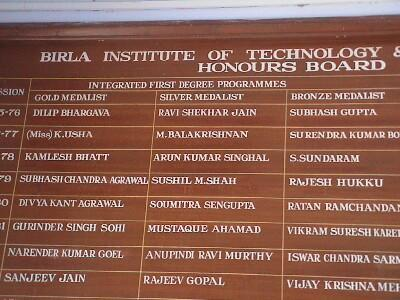 Rajesh
loves the rivalry and constantly takes joking pot-shots
at the IITs. “The engineers from lesser known
institutes like IITs are all over the place” he joked
at the BITS Mumbai reunion.
“Its time we BITSians show them what we are
made of”.
Rajesh
loves the rivalry and constantly takes joking pot-shots
at the IITs. “The engineers from lesser known
institutes like IITs are all over the place” he joked
at the BITS Mumbai reunion.
“Its time we BITSians show them what we are
made of”.
A EEE graduate from
BITS, he was the bronze medalist of his batch at Pilani.
His name is still painted on the S-Block winner board.
Rajesh believes that his formative years in Pilani
equipped him with the people skills that guide him
today.
The Road to Entrepreneurship
After graduating from
BITS, Rajesh joined TCS in their
Bombay
office in 1979.
TCS was a small company writing code for US
companies long before IT outsourcing became fashionable.
Rajesh observed that the code TCS was writing for
American firms were being sold for substantially large
profits. He realized that though Indians were excellent
software developers, they were weak in two areas i.e.
understanding the customer’s businesses and managing
large turnkey projects.
Rajesh’s moment of
truth came in late 1980s.
Rajesh wrote software that integrated the work
done by multiple workstations at the
US
stock exchange into a
single box. This system was an instant hit and the
company was sold to Reuters for $150 million. TCS, which
had built the product, collected a few thousand dollars.
That is when Rajesh decided that someday he would build
a product instead of selling his innovative skills to
others for much less.
i-flex gets started
Rajesh was getting dissatisfied with his TCS experience.
He worked on projects in different fields and
verticals, which did not allow him to build domain
knowledge, a critical step towards a building a product.
He decided to move to Citicorp Overseas Software
Ltd. (COSL) in 1989 to focus on the financial market
vertical.
At the time, COSL was a 500-employee Citibank subsidiary containing one
product, Microbanker.
But most of its revenues were from providing IT
services to Citibank.
Microbanker was mostly ignored by COSL.
It fascinated Rajesh, because it was a core
system with capabilities to run the guts of the bank.
It wasn’t very good, but he thought it held
tremendous potential.
In 1992, Rajesh discovered that COSL was converting itself into an
internal IT shop, and had no interest in investing or
selling Microbanker to other customers. Rajesh, along
with co-founder R Ravisankar (also called Shanx) decided
they would attempt to separate the company by
spinning-off the product.
After a number of discussions within COSL, the
firm agreed. Citibank saw a lot of promise in this young
group of professionals and clearly was impressed by the
passion of Rajesh Hukku.
As part of the deal, all employees of COSL were
offered the opportunity to go to the new firm, CITIL.
150 employees accepted the offer.
Rajesh negotiated $400,000 (Rs. 1 crore at the time) in seed funding from
Citicorp Venture Capital (CVC), and named the startup
CITIL. Rajesh was named CEO. Today the employees own a
20% stake in the company.
CITIL focused on selling Microbanker to banks in
emerging market countries and did not get any business
from Citicorp in the initial years to bootstrap itself,
as COSL was doing all the work. But after a few years as
CITIL started winning Citicorp business, the stage was
set for a rivalry with the larger, better established
COSL. COSL was eventually sold to Polaris.
CITIL built a product that had global applications yet it didn’t have
the resources to brand itself.
Rajesh solved this problem by focusing his energy
at the less expensive Middle Eastern and African
markets. He made an interesting realization that even
though the economies in
Africa
were in shambles, the banks in
Africa
had money. He
leveraged the Citibank name to open doors, and the
small, relatively unknown banks sat up and listened.
As the product generated revenues, it was
gradually introduced all around the world and is firmly
established today. In 2000, the company changed its name
to i-flex, giving up the Citi prefix.
What is little known is that Citibank wasn’t the first customer for
i-flex’s products, although Citibank did buy its
services. It was actually the 47th, client,
the culmination of a three-year sales effort spearheaded
by Rajesh. Eventually
Citibank was to give the company a contract to replace
their legacy system in 100 countries.
This system will standardize 59 systems owned by
Citibank into a single FLEXCUBE system. The savings for
Citibank will far outweigh the investment.
The venture capitalists benefited hugely from this deal.
The $400,000 investment by CVC is now worth more
than $400 million. It is certainly the largest return
for any VC in
India
,
and probably the largest ever for CVC.
CVC currently owns 43.5% of i-flex.
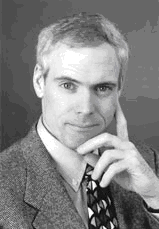 Jim
Collins. Photo credit: Businessweek
Jim
Collins. Photo credit: Businessweek
His
Management Style
Rajesh
is a "Level 5
manager," a reference to management guru Jim
Collins' depiction. He has a very democratic style of
working and he relies heavily of building consensus in
the boardroom. He
also has a disarming sense of humor and an uncanny
ability to crack a joke and connect with people.
This style of functioning has given him an almost
cult following in i-flex and given rise to many stories
about him.
Five years ago, a newly minted MBA had just joined i-flex. The first
day, he bumped into Rajesh in the elevator leaving the
office. Rajesh promptly extended his hand and said,”
Hi! I am Rajesh. What
is your name?” The startled rookie said, “Sir my
name is ----. I
recently joined i-flex and it’s great to work for your
company”. Rajesh
smiled, “i-flex is not only my company. It’s your
company as well. We are all building this company
together”. The employee remembers that day vividly,
and is currently part of i-flex’s
Singapore
operations.
Rajesh’s
wit and deft handling of situations has many legendary
stories. One story told often is when he
was trying to convince a large European bank to replace
its crazy quilt of back-office computer software with
i-flex’s product. An executive gave him the brush-off,
telling him their company's system was so complicated,
only God could figure it out. Rajesh, in his inimitable
style, made a deft save. "Sir, we are
Indians," he said. "We are very religious, and
very close to God." Hukku won the deal.
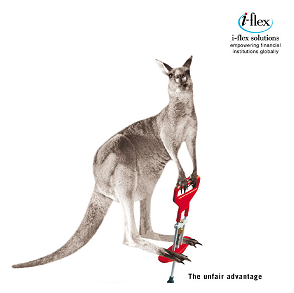 The
Branding challenge
The
Branding challenge
By leveraging the Citibank name and by giving outstanding products and
services to customers ignored by the larger competitors,
i-flex built its marketshare.
When it became big enough, it leveraged its size
into building the brand. It wasn’t easy.
When i-flex started in 1992, there was not a
single globally recognized Indian brand in any industry,
and i-flex went through some tough times convincing its
clients about its Made-in-India products. Rajesh still
reminisces, "On many occasions, the CIO of a bank
would tell me ours was the ideal product. But the CEO
would not agree to buy it because he didn’t want to
take a risk."
 All
that is history. i-flex
is one of the most widely dispersed Indian brands. Only
recently that have the likes of Vijay Mallaya of
Kingfisher, Titan and Indian pharmaceutical companies
begun to follow in his footsteps, giving their brands a
global face.
All
that is history. i-flex
is one of the most widely dispersed Indian brands. Only
recently that have the likes of Vijay Mallaya of
Kingfisher, Titan and Indian pharmaceutical companies
begun to follow in his footsteps, giving their brands a
global face.
The next challenge for i-flex is to crack the
US
market, a nation with
more banks than fast food restaurants.
(We’re only joking, but the
US
has over 8,000 different
banks). The
market potential is staggering.
Rajesh wants to utilize brand equity as the
single most effective tool for market penetration.
The Awards
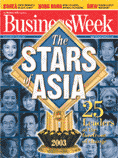 Rajesh
says that the awards were missing when they needed it
the most, but as they have been successful, the awards
have flown fast. Rajesh has been awarded
India
’s highest award for
Innovation, the Dewang Mehta Award in 2003. Rajesh
donated the entire sum of Rs. 5 lakhs to the “i-flex
for child” charity program.
Rajesh
says that the awards were missing when they needed it
the most, but as they have been successful, the awards
have flown fast. Rajesh has been awarded
India
’s highest award for
Innovation, the Dewang Mehta Award in 2003. Rajesh
donated the entire sum of Rs. 5 lakhs to the “i-flex
for child” charity program.
He was named Star of Asia by BusinessWeek.
i-flex was one of the 15 survivors of the dotcom crash
profiled by the Time Magazine. Rajesh has been named one
of
India
’s top 10 movers and
shakers in the IT Industry, received the Entrepreneur of
the Year for the ICE category, and won the Emerging
Company of the Year award from ET, amongst many others
in
India
. And in October 2004,
Forbes ranked i-flex amongst the best 100 companies
‘under a billion’ in Asia Pacific adding to the long
list of accolades received by the firm.
i-flex: An amazing work place
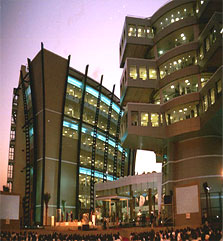 Rajesh
lives and breathes i-flex. It
is his mission to make i-flex the role model for
innovation coming out of
India
.
His personal mission means he is on the road 15
days in a month. ‘When
he is not traveling, he is applying for visas “says
Head of Media Relations, Sunil Robert in
London
. Employee turnover till
recently had been minimal, in part due to personal
interactions of employees with Rajesh.
He has an amazing memory and can recollect little
details about his workers many years later.
Rajesh
lives and breathes i-flex. It
is his mission to make i-flex the role model for
innovation coming out of
India
.
His personal mission means he is on the road 15
days in a month. ‘When
he is not traveling, he is applying for visas “says
Head of Media Relations, Sunil Robert in
London
. Employee turnover till
recently had been minimal, in part due to personal
interactions of employees with Rajesh.
He has an amazing memory and can recollect little
details about his workers many years later.
But of late it has been hard to hold onto
i-flex employees. Known
for their technical abilities and knowledge of building
products, they are targets for companies willing to pay
significantly higher wages.
It has been reported recently that SAP and
Infosys, amongst others have been trying to poach the
product champions. But
the company refutes this. “On the base of more than
3,000 employees, a handful of people leaving was noted
and a straw case was made out of that incident”, says
Sunil Robert.
Employees return often, after they realize
the culture at i-flex is unique, they see the lack of
empowerment at other firms, and most importantly, they
don’t find employees at other firms with the same
passion and missionary zeal as their counterparts at the
firm they left. Rajesh always welcomes them back.
Rajesh, BITSAA and relaxation
Rajesh has spoken in Mumbai and
New Jersey
, and is happy to show up
at BITSAA events around the globe.
When he’s not selling software, getting visas
or inspiring students and alums, he entertains friends
and family. Rajesh is a great mimic and fan of Raj
Kapoor.
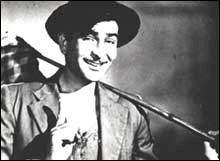 Employees
say that the early days of NASSCOM were memorable
evenings, with Dewang Mehta, a close friend of Rajesh,
an who had the same sense of humor and idea of fun as
Rajesh did, laughing, joking and partying with other
leaders of India’s IT industry. .
Employees
say that the early days of NASSCOM were memorable
evenings, with Dewang Mehta, a close friend of Rajesh,
an who had the same sense of humor and idea of fun as
Rajesh did, laughing, joking and partying with other
leaders of India’s IT industry. .
Rajesh tries to spend every free moment with
his family. He is not too concerned about improving his
golf game, “I don’t have to learn golf because if I
become good at golf, the CEOs I work with will feel
threatened. So long as I am bad at golf, they will
thrash me at it but still give me their business.” he
jokes, half seriously.
Miles to go
i-flex shares have risen 107% since their
IPO in June 2002. But of late, while the coding giants
are on a tear, i-flex is down 35% from its peak in
January this year.
Rajesh dismisses this as short-term myopia,
and is seldom distracted by the share price. He’s
building i-flex in the
US
and
Europe
, spending money on
acquisitions, and broadening his product offerings and
company into a diversified provider of banking and
financial solutions for the long term.
i-flex is growing rapidly.
And will hire about 1,000 professionals in the
next 5 months by March 2005.
In his view, this is only the beginning.
We believe him and are assured that Rajesh
will be collecting his 150,000 miles next year as well. ¨
